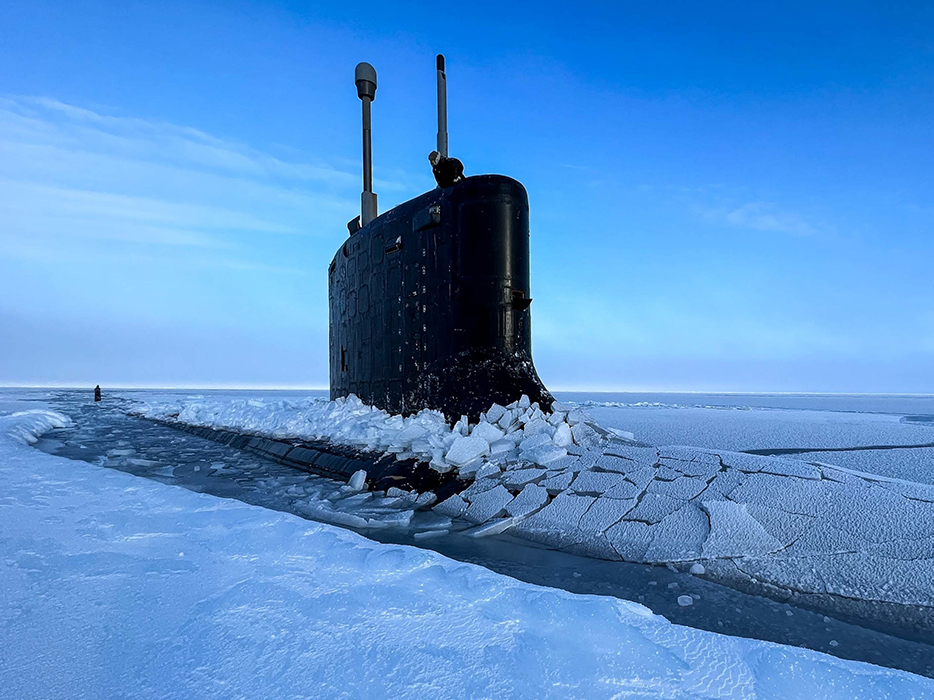The biennial ICEX exercise seeks to explore and protect potential trade routes off the northern coast of Alaska. The fourth edition of this exercise employed the Micro Weather Station from Intellisense Systems to gather environmental data in the most remote expanses of the Arctic Ocean.
For millennia, the Arctic Ocean has been covered by miles and miles of sea ice, making it impassible by boat. But with global temperatures rising due to climate change, this ice shelf is slowly eroding and thus opening potential passageways across the North Pole. These routes offer a much faster and more efficient means of providing global trade for nations in the Northern Hemisphere. Now, many countries are hoping to explore, protect, and utilize this formerly inaccessible territory on the top of the world.
This opportunity prompted the United States Navy to conduct a biennial military exercise that pursues scientific study of the Arctic region and evaluates the readiness of the Navy’s submarine force in arctic conditions. The exercise, called ICEX, typically takes place over three weeks and includes over 200 participants from several nations, including the United States, Canada, United Kingdom, and Norway.
“The Arctic region can be unforgiving and challenging like no other place on Earth,” said Rear Adm. Richard Seif, the ranking officer of ICEX 2022 and commander of the Navy’s Undersea Warfighting Development Center in Groton, Connecticut. “It’s also changing and becoming more active with maritime activity. ICEX 2022 provides the Navy an opportunity to increase capability and readiness in this unique environment, and to continue establishing best practices we can share with partners and allies who share the U.S.’s goal of a free and peaceful Arctic.”
Before the exercise began, the U.S. Navy established a temporary camp on an ice floe 160 nautical miles off the northern coast of Alaska. Dubbed Ice Camp Queenfish, it consisted of a command center and several shelters to safely house and support more than 60 service members in subzero temperatures. There, members of the Strike Group Oceanography Team (SGOT) from Norfolk, Virginia installed the lightweight, portable Micro Weather Station (MWS®) from Intellisense Systems to capture important environmental data before more personnel arrived. This data included cloud layer height, precipitation, temperature, and wind speed and direction. The MWS was able to provide essential weather observations on the northern most point of Alaska where no meteorological information was previously available.
“At Ice Camp Queenfish, our teams can test equipment in a very harsh and demanding environment,” said Howard Reese, director of the Arctic Submarine Laboratory. “It’s important that all the technology we’re testing can perform in all of the oceans of the world, including the Arctic. Here, we can learn what works well in the Arctic and what doesn’t work as well, and we can make changes and improvements.”
Intellisense has already proved that the MWS could withstand the unpredictable weather of Alaska. In 2021, a commercial version of the MWS was installed on Unalaska Island in the Bering Sea to support the construction of a geothermal power plant. Over the course of its year-long deployment, this MWS has endured subzero temperatures and unforgiving winds. It has remained operational thanks to its built-in solar power system and integrated battery pack, which can supply additional power in the event of low solar exposure in the Arctic Circle.
 With Ice Camp Queenfish established, the exercise officially kicked off on March 5, 2022. The USS Pasadena (SSN 752), a Los Angeles-class fast-attack submarine, dramatically surfaced through the sea ice in Prudhoe Bay, Alaska. Exercises like ICEX 2022 enable the U.S. Navy to test and evaluate the operational capabilities of its fleet in arctic conditions. And thanks to innovations like the MWS, they can transport personnel and conduct research safely with reliable, accurate weather data.
With Ice Camp Queenfish established, the exercise officially kicked off on March 5, 2022. The USS Pasadena (SSN 752), a Los Angeles-class fast-attack submarine, dramatically surfaced through the sea ice in Prudhoe Bay, Alaska. Exercises like ICEX 2022 enable the U.S. Navy to test and evaluate the operational capabilities of its fleet in arctic conditions. And thanks to innovations like the MWS, they can transport personnel and conduct research safely with reliable, accurate weather data.
“A big part of this is building on the submarine community’s history, going back to the 1940s, operating in the Arctic,” said Lt. Mike Reid, an exercise range safety officer who supported ICEX from the Navy’s Norfolk-based Operational Test and Evaluation Force. “This demonstrates that we not only haven’t lost that skill set, but we’re always learning, improving and building upon the lessons we’ve learned over the decades. ICEX 2022 is an exciting opportunity for the junior personnel to take part in that history and carry on that tradition.”
